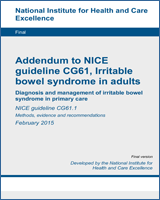From: 2, Evidence review and recommendations

NCBI Bookshelf. A service of the National Library of Medicine, National Institutes of Health.
| Included studies | Population | Intervention and comparator | Outcomes | |
|---|---|---|---|---|
| Chey (2012) |
804 participants meeting Rome II criteria for IBS-C. 18+. Eligibility for randomisation: average score of ≥3 for daily abdominal pain at its worst (11 point rating scale) and an average of <3 Complete Spontaneous Bowel Movements (CSBMs) per week and ≤5 Spontaneous Bowel Movements (SBMs)/week during the baseline period (12 weeks) not necessarily consecutive, in the 12 months before the screening visit. Mean age 44yrs, Female 90%, White 78%. Significantly higher proportion of men in placebo arm than the linaclotide arm (12.7 vs 8.2% p=0.037). |
Linaclotide 290µg orally once daily, 30 mins before breakfast. N=401 Placebo |
12 weeks and 26 weeks respectively.
| |
| Rao (2012) |
800 participants As above (Chey 2012) Mean age 44 years, 90.5% female. |
Linaclotide 290µg once daily. Timing not specified. N=405 Placebo |
| |
| Johnston (2010) | 420 participants 18+ Rome II criteria <3 SBMs per week and ≥1 of the following for at least 12 wks in the preceding 12 months:
Mean score of ≥2 for abdominal (non-menstrual) pain or discomfort on 5 point scale 1=none, 5=very severe) and Mean of <3 CSBMs and ≤6 SBMs per week. Discontinuation of ineligible medication (e.g. anticholinergic agents, opiods). Mean Age 44. Female 92%. |
Linaclotide once daily BEFORE first meal. 290µg dose arm reported only. N=84 Placebo |
| |
| Quigley (2013) | 803 participants (Trial 1, Rao (2012) as above. 805 participants (Trial 2, Chey (2012) as above, |
Linaclotide 290µg (as above) Placebo |
| |
| Whitehead (2011) |
62 patients with physician diagnosis of IBS and Rome III criteria for IBSC. Age 18+ Baseline Characteristics: (not reported by arm) Mean age (SD) 41.95 (13.56), 85.5% Female. Average IBS Severity Score at baseline was 296 (95% CI 274,317). Percentage per score category: Mild (score<175) - 8.1% Moderate (175–300) - 46.7% Severe (>300) - 45.2% |
Lubiprostone 48µg, one capsule twice daily. (n=62 or 60) Placebo |
After treatment period 2
| |
| Drossman (2009) | Combined n= 1171 Study A n=590 Study B n=581 Rome II diagnosis of IBS-C. Age 18+. Compliance with daily diary completion ≥70% during the 4 week baseline period. Min 2 of the following
Mean Age 47years, 91.6% female. |
Lubiprostone 16µg (8µg twice daily) with breakfast and dinner and with 8oz water Study A n=390 Study B N=379 Placebo |
| |
| Johanson (2008) | 195 participants of 18–80 years old, not pregnant, not lactating. Rome II diagnostic criteria for IBS Rome II modular questionnaire criteria for IBS-C Sigmoidoscopy or colonoscopy within 5 years to rule out other causes/diseases. In 4 week initiation period
Min 2 of the following
|
Lubiprostone 16, 32, 48µg per day, Split into 8µg twice daily (n=51), 16µg twice daily (n=49) or 24µg twice daily (n=45) with breakfast and dinner and 8oz H20. Placebo |
| |
From: 2, Evidence review and recommendations

NCBI Bookshelf. A service of the National Library of Medicine, National Institutes of Health.